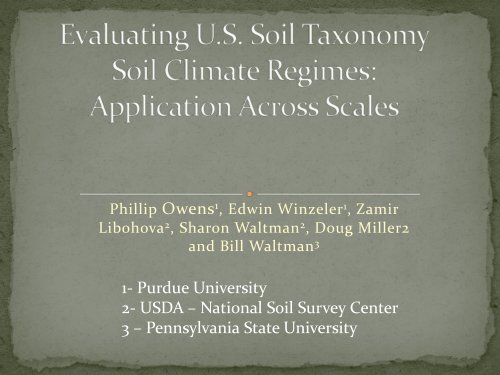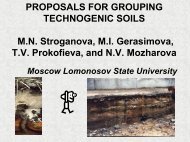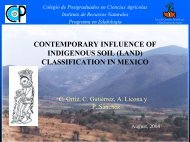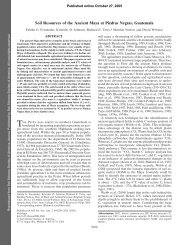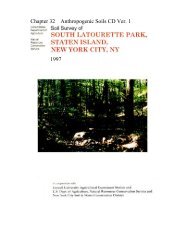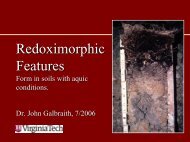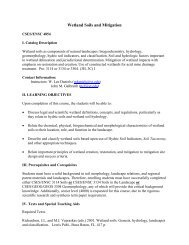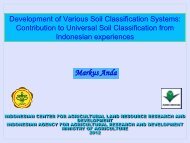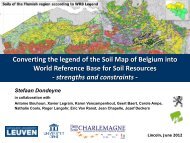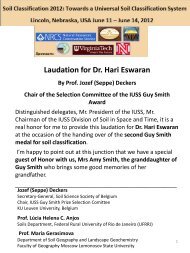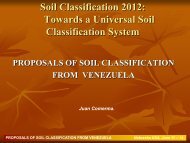Evaluating the US Soil Taxonomy Soil Moisture Regimes
Evaluating the US Soil Taxonomy Soil Moisture Regimes
Evaluating the US Soil Taxonomy Soil Moisture Regimes
Create successful ePaper yourself
Turn your PDF publications into a flip-book with our unique Google optimized e-Paper software.
Phillip Owens 1 , Edwin Winzeler 1 , Zamir<br />
Libohova 2 , Sharon Waltman 2 , Doug Miller2<br />
and Bill Waltman 3<br />
1- Purdue University<br />
2- <strong>US</strong>DA – National <strong>Soil</strong> Survey Center<br />
3 – Pennsylvania State University
• Includes soil temperature and moisture regimes<br />
• The climate can be measured OR estimated from<br />
models (Newhall model) OR by expert knowledge<br />
• The main divisions of climate were based on <strong>the</strong> use of<br />
<strong>the</strong> soil (Smith, 1986)<br />
– <strong>Soil</strong>s too dry to grow non irrigated crops (Aridic)<br />
– <strong>Soil</strong>s that grow crops without irrigation (Udic)<br />
– <strong>Soil</strong>s that grow drought tolerant crops (Ustic)<br />
– Aquic (wet soils) and Xeric (Mediterranean climate)
Upper boundary – depth where 2.5 cm rainfall will<br />
reach in 24 hours<br />
Lower boundary – depth where 7.5 cm rainfall will<br />
reach<br />
Generally 10-30 cm below <strong>the</strong> soil surface, 20-60 cm if<br />
coarse loamy, 30-90 cm sandy
• Aquic<br />
– saturated several weeks each year<br />
– reducing conditions<br />
– low chroma (gray) colors<br />
• Perudic<br />
– very humid climate<br />
– soil remains very most year-round, but not aquic<br />
– precipitation > PE every month<br />
– large surplus, no deficit<br />
• Udic<br />
– humid climate<br />
– surplus, little or no deficit
• Ustic<br />
– semi-arid climate<br />
– moderate deficit, little or no surplus<br />
– Not dry > 90 days cumulative; < 22 C and dry no more than 45 consecutive days<br />
6 out of 10 years; > 22 C and dry for 90 cumulative days<br />
• Aridic<br />
– desert climate<br />
– large deficit, no surplus (dry greater that 90 consecutive days & >8 C)<br />
• Xeric<br />
– Mediterranean climate--dry summer, moist winter<br />
– moderate surplus, moderate deficit<br />
– Dry 45 consecutive days within 4 months of summer and wet 45 consecutive<br />
days within winter<br />
• <strong>Soil</strong> <strong>Moisture</strong> <strong>Regimes</strong> reflect regional Climate, mainly precipitation<br />
– exception: aquic moisture regime controlled primarily by local conditions
• Saturation with reduction (gray soil colors). Water is<br />
relatively stagnant.<br />
– Episaturation<br />
• water table perched by layer with slow permeability<br />
– Endosaturation<br />
• water table not perched<br />
– Anthric saturation<br />
• water table perched because of man's activities (i.e., rice<br />
paddys)<br />
• Saturation without reduction (reddish or brownish soil<br />
colors). Water moves in landscape.<br />
– Oxyaquic
© Purdue University
Mean annual soil<br />
temperature (C)<br />
< 8° Cryic (colder<br />
summers)<br />
< 8° Frigid (warmer<br />
summers)<br />
Mean summer minus mean winter<br />
soil temperature (C)<br />
>5° 22° Hyper<strong>the</strong>rmic Isohyper<strong>the</strong>rmic<br />
Mean annual soil temperature is about 1° C higher than mean annual air<br />
temperature.
© Purdue University
Newhall Model
Monthly Air Temperature
Guy Smith, Rationale for Concepts in <strong>Soil</strong> <strong>Taxonomy</strong>,<br />
1986<br />
… a good man could just look at <strong>the</strong> assembled vegetation and<br />
give you an excellent ideaof <strong>the</strong> soil moisture and temperature<br />
regime at that point. Their experience is extremely<br />
important…<br />
There is a vast body of knowledge on <strong>the</strong> soil moisture in <strong>the</strong><br />
hands of <strong>the</strong> cultivator. They know much more about it than<br />
<strong>the</strong> pedologist who is out <strong>the</strong>re who just wants to make a soil<br />
survey. They can from <strong>the</strong>ir knowledge give him a great deal of<br />
help in deciding whe<strong>the</strong>r he is dealing with ustic moisture<br />
regime or not.<br />
“Know” and “knowledge” appear 19 times in 3 pages of discussion<br />
of soil moisture regimes in <strong>the</strong> Rationale for Concepts in ST.
Smith, 1986, talking about <strong>the</strong> moisturecontrol<br />
section:<br />
The purpose of <strong>the</strong> moisture control section was to<br />
permit <strong>the</strong> calculation of moisture regimes from <strong>the</strong><br />
climatic data because we are quite aware that it would<br />
rarely be measured.<br />
The [MCS] that we select seems to permit an estimation<br />
by <strong>the</strong> model developed by Newhall. The assumption is<br />
always that <strong>the</strong>re is no loss of water by runoff or<br />
accumulation by run-on.
<strong>Soil</strong> – simple sponge with available water capacity<br />
Monthly precipitation values fill slots in <strong>the</strong><br />
conceptual sponge<br />
Monthly evopotranspiration calculated with<br />
Thorthwaite’s formula removes moisture from <strong>the</strong> slots<br />
differentiallywith depth<br />
<strong>Moisture</strong> drains out <strong>the</strong> bottom<br />
Precipitation in excess of capacity is treated as runoff<br />
and ignored
No consideration of soil drainage restriction<br />
Can’t predict Aquic moisture regime<br />
Would require morphological evidence of<br />
wetness<br />
Local convergent and divergent water behavior<br />
Climatic record can’t help to predict local<br />
topographic effects<br />
Ignores snowpack and snowmelt dynamics
Monthly temperature and precipitation data from PRISM<br />
Climate Group (prism.oregonstate.edu) (o<strong>the</strong>r sources are<br />
also available – WorldClim, e.g.)<br />
Normals from 1971 -2000<br />
½ arcsecond resolution ~800 m pixel size<br />
<strong>Soil</strong> Root Zone Available Water Holding Capacity<br />
(STATSGO2 dataset, NRCS)<br />
Gridded STATSGO2 Dataset<br />
Processed at NGDC<br />
Elevation values (Shuttle Radar Topography Mission,<br />
http://www2.jpl.nasa.gov/srtm/)<br />
Geographic Coordinates foreach estimate<br />
Expected offset between soil temperature and atmospheric<br />
temperature
<strong>Soil</strong> moisture class<br />
<strong>Soil</strong> temperature class<br />
Subgroup modifiers<br />
Van Wambeke proposed modifiers<br />
1975 and 2010 <strong>Soil</strong> <strong>Taxonomy</strong> modifiers<br />
Yearly soil moisture and temperature estimates<br />
Numberof days per year soil is moist and above 5° C, 8°<br />
C, dry and above 5 or 8<br />
Cumulative moist, dry, moist/drysoil days<br />
Annual and Summerwater balance
Aquic<br />
• Xeric bias toward westcoast<br />
• Ustic bias toward plains states<br />
• Nearabsenceof perudic
Aquic
Aquic
Newhall <strong>Soil</strong> <strong>Moisture</strong><br />
<strong>Regimes</strong>: Brazil
Newhall <strong>Soil</strong> <strong>Moisture</strong> with<br />
Van Wambeke Divisions: Brazil
<strong>Soil</strong> climate governs many land uses<br />
Global societal issues (food security, climate change<br />
and nutrient cycling) depends on understanding soil<br />
climate.<br />
With models and available data, soil climate<br />
predictions are easily determined<br />
<strong>Soil</strong> climate information should be retained in <strong>the</strong><br />
Universal <strong>Soil</strong> Classification System
•From Thornthwaite’s original 1948<br />
publication, An approach toward a<br />
rational classification of climate.<br />
• Classes<br />
Average Annual Potential Evapotranspiration<br />
1971-2000<br />
•Calculated from monthly precipitation and<br />
temperature data using Thornthwaite’s<br />
formula and PRISM inputs<br />
•Pixel-by-pixel estimates
Monthly Air Temperature
What actual soil<br />
information is<br />
used in <strong>the</strong><br />
estimates from<br />
NOAA?
Climate – long-term trends in wea<strong>the</strong>r<br />
Pedogenesis & geological timescales<br />
Tracking <strong>the</strong> pace of soil change


